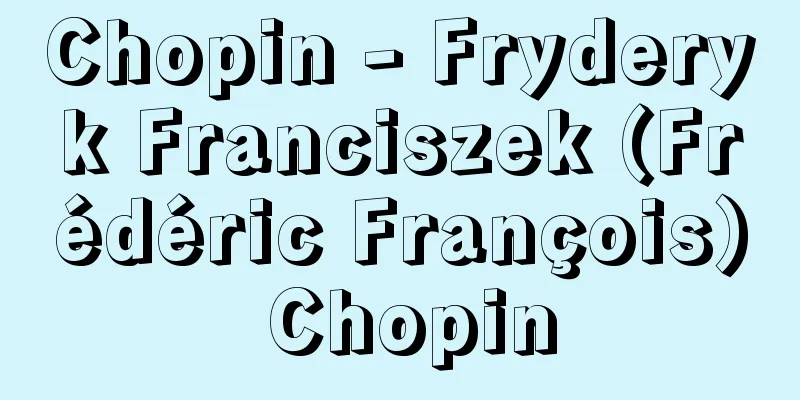Chopin - Fryderyk Franciszek (Frédéric François) Chopin

|
A Polish composer and pianist who opened up unparalleled new horizons in piano music. Most of his major works are piano pieces, and his unique and innovative style is based on lyricism, combining a variety of characteristics such as valiantness, elegance, and melancholy. He has been praised as the "poet of the piano" and is loved worldwide. His father, Nicholas, was a Frenchman who had moved to Poland at the age of 16, and his mother, Justyna, was a Polish woman of fallen nobility. Frédéric Chopin was born as the eldest son in Zelazowa Wola, near Warsaw. There are various theories about his birth date, with March 1, 1810 being the most commonly accepted, but 1809 is also widely accepted. His parents and the rest of his family loved music, but from the age of 4 or 5 he received piano lessons from his older sister Ludwika, and from 1816 he studied under Wojciech Adalbert Żybny. He showed an interest in composition from around the age of 7 or 8, and composed several piano pieces, including folk dances and rondos. His polonaise, written in 1817, was published immediately after composition and is still known to this day as one of his earliest works. He excelled in composition and improvisation even back then, and was rumored to be the "successor to Mozart" among music lovers in Warsaw. On February 24, 1818, Chopin held his first public concert, which was a great success, and he became a favorite of the aristocracy. Soon he surpassed his teacher Żybny, and in 1826 he entered the Warsaw Conservatory, where Elsner was the director, under the guidance of Józef Elsner, who was widely regarded as the best musician in Warsaw. Elsner's teaching method focused on the free development of originality and avoided forcing students into a mold as much as possible. This was extremely beneficial in forming Chopin's unique compositional style, but at the same time it also led to his lifelong desire to master techniques such as counterpoint, and the struggles he faced with the composition of large-scale works. In his second year, he was assigned a concerto as an assignment, and composed "Variations on La ci daremu la mano (Please give me your hand)" on a theme by Mozart, which later led to Schumann's comment, "Take off your hats, gentlemen, this is a genius," spreading Chopin's name throughout Europe. During this period, he focused on composing piano pieces for orchestra as a stepping stone to entering the European music scene and to a career of composing and performing his own music. His works, such as Rondo à la Cracowiak (1828), Piano Concerto No. 2 in F minor, and Piano Concerto No. 1 in E minor (both 1830), are characterized by their technical and flamboyant style, which was highly conscious of the virtuosity of the masters such as Czerny, who were popular in Vienna at the time as students of Beethoven, and the lyric beauty represented by Hummel. After graduating from the Conservatory, he decided to leave Warsaw in search of a wider field of activity, and gave a farewell concert in October 1830, traveling to Vienna in November. However, upon hearing the news of anti-Russian riots and the failure of the Russian Revolution in his homeland, he was overcome with grief, indignation and despair. Although he himself did not choose to join his comrades in the crisis facing his homeland, this incident cast a decisive shadow over his young soul, and became the source of the tragedy and nihilism that underpinned his compositions. Chopin, clearly aware that he had to live as an artist, gave up on returning to his homeland, and never set foot on the soil of his homeland again. In mid-September 1831, he settled in Paris, the city of freedom where many intellectuals and artists gathered. Despite his difficulties, he continued to devote his skills to music. He also attended operas every day, receiving profound inspiration from Bellini and others about the meaning of melody. He studied ways of making the piano sing supple melodies like the human voice, and established a unique musical idiom, incorporating accent shifts and rhythmic ingenuity, harmonic innovations and changes in tone, and developing the ternary form to incorporate his own original musical ideas. In Paris, pianist Kalkbrenner, composers such as Liszt, Rossini, Cherubini, and Berlioz, writers such as Hugo, Musset, Heine, Balzac, Chateaubriand, and Lamartine, and painters such as Delacroix and Ingres were all competing for beauty. Chopin, too, was invited to soirées after his successful Paris debut in 1832, where he gave piano lessons to ladies, frequented salons wearing his trademark white gloves, performed when invited, and made friends with aristocrats and artists. In 1836, he met the female writer George Sand through Liszt's introduction, and two years later they began living together, living together for nine years. During this time, Chopin, who had been suffering from pulmonary tuberculosis, moved to Majorca to recuperate, where he completed 24 Preludes (1839). Even after that, despite his deteriorating health, his creativity flourished as he refined and complicated rhythms, expanded forms, and emphasized fantasy, and he released a succession of masterpieces, including Piano Sonata No. 2 in B flat minor "Funeral March" (1839), Piano Sonata No. 3 in B minor (1844), Fantasia (1841), "Fantaisie Polonaise" (1846), Ballade No. 2 (1839), Ballade No. 3 (1841), and Ballade No. 4 (1842), which won him fame. In 1848, to escape the hustle and bustle of the February Revolution, he traveled to London, a long-desired destination, and also traveled to Scotland, but his condition worsened due to the thick fog and cold, and he returned to Paris, but he was financially strapped, and he died alone and anxious on October 17, 1849. Chopin reached the peak of his creative period during a time when the performance of the piano was rapidly improving and developing, and his works are closely linked to the expansion of playing techniques and pedaling techniques. In particular, his etudes are filled with advanced musical ideas and their results, and are monumental masterpieces that serve as exercises to hone performance techniques, while also giving various forms to the secrets of piano expression that he discovered. Among his predecessors, he loved the nocturne style of Bach, Mozart, and Field, and incorporated the results of his research into his compositions. The rhythm and spirit of the Polish folk dances, the mazurka and polonaise, were a great support for him, and he created many masterpieces that artistically sublimated them. His works range from easy-to-play waltzes and nocturnes to extremely difficult etudes, but outside of his piano works, his cello sonatas (1846) and songs are relatively well known. [Aozawa Yuio] "Chopin" by Tetsutaro Kawakami (1962, Ongaku No Tomosha)" ▽ "Chopin" by Ikko Toyama (1976, Shinchosha)" ▽ "Chopin" by Yuio Aosawa (1986, Geijutsu Gendaisha)" ▽ "Camille Bourniquel Chopin (1957, Editions du Seuil, Paris)" ▽ "Alfred Cortot Aspects de Chopin (1949, Editions Albin Michel, Paris)" ▽ "Arthur Hedley Chopin (1947, JM Dent and Sons Ltd., New York)" ▽ "Arthur Hedley Selected Correspondence of Fryderyk Chopin (1962, Heineman, London)" [Reference] |It is located in the garden of Chopin's birthplace (Chopin Museum) in Żelazowa Wola. Near Warsaw, Poland ©Shogakukan "> Chopin Statue Source: Shogakukan Encyclopedia Nipponica About Encyclopedia Nipponica Information | Legend |
|
ピアノ音楽に比類ない境地を開いたポーランド出身の作曲家、ピアニスト。主要な作品のほとんどがピアノ曲で、その個性的で斬新(ざんしん)な書法はリリシズムを基調に、雄々しさ、気品、メランコリーなど多彩な性格をあわせもち、「ピアノの詩人」とたたえられ、世界的に親しまれている。 父ニコラスは16歳のときからポーランドに移り住んだフランス人、母ユスティナは没落貴族の出のポーランド人で、フレデリック・ショパンは長男としてワルシャワ近郊のジェラゾワ・ウォーラに生まれた。生年月日については諸説があり、1810年3月1日が一般に支持されているが、1809年説も有力である。両親をはじめ家族そろって音楽を愛好したが、4、5歳から姉のルドウィカにピアノの手ほどきを受け、1816年からはウォイチェフ・アダルベルト・ジブヌイに師事した。7、8歳ごろから作曲に興味を示し、民族舞曲やロンドなどいくつかピアノ曲をつくったが、1817年作のポロネーズは作曲後すぐに出版され、最初期の作品として今日に伝えられている。当時から作曲や即興演奏に秀で、ワルシャワの音楽愛好家たちの間では「モーツァルトの後継者」などと噂(うわさ)されていた。 1818年2月24日、最初の公開演奏会を開き大成功を収めて、貴族社会の寵児(ちょうじ)となった。そしてほどなく師のジブヌイをしのぐほどの上達をみせ、ワルシャワ随一の音楽家と世評の高かったユセフ・エルスネルの指導を受けて、1826年にはエルスネルが院長を務めるワルシャワ音楽院に入学した。エルスネルの教育法は独創性を自由に伸ばすことを主眼とし、型にはめることを極力避けるものであった。それはショパンの個性的な作曲語法の形成にきわめて有益であったし、同時にまた、生涯にわたる対位法などの技術修得への渇望や、規模の大きな作品での構成的な苦心の原因ともなった。2年生のときに協奏的作品を課題として与えられ、モーツァルトの主題による『ラ・チ・ダレム・ラ・マーノ(お手をどうぞ)の変奏曲』を作曲したが、この作品はのちにシューマンの「諸君、帽子をとりたまえ、天才ですぞ」の評言によってショパンの名をヨーロッパ中に広めることになった。この時期、ヨーロッパ楽壇への進出や自作自演による音楽活動への布石としてオーケストラを伴うピアノ作品を集中的に作曲したが、『ロンド・ア・ラ・クラコビアク』(1828)、ピアノ協奏曲第2番ヘ短調、同第1番ホ短調(ともに1830)など、当時ウィーンで人気の高かったベートーベン門下の巨匠チェルニーらの名技主義やフンメルなどに代表される叙情美を多分に意識した技巧的で華やかな作風が特徴的である。 音楽院を卒業すると、より広い活動の場を求めてワルシャワを離れることを決意、1830年10月に告別演奏会を開き、11月ウィーンに旅立ったが、故国での反ロシア暴動、独立革命失敗の報を聞き悲憤と絶望に憔悴(しょうすい)した。彼自身は故国の危機に際して同志たちと行動をともにすることを選ばなかったが、この事件は若い魂に決定的な影を落とし、彼の創作の根底に流れる悲劇性やニヒリズムの源となった。ショパンは芸術家として生きるべきことをはっきりと自覚して帰国を断念、以後二度と故国の土を踏むことはなかった。 1831年9月中旬、自由の都としてさまざまな文化人や芸術家たちの集まるパリに落ち着き、不遇のうちに研鑽(けんさん)を積むかたわら、連日オペラに通いベッリーニなどから旋律のもつ意味について深い啓示を受け、ピアノという楽器に人間の声のようなしなやかなメロディを歌わせる表現方法を研究、アクセントの移動とリズムのくふう、和声上の革新や音色変化、三部形式を発展させて独自の音楽的発想を盛り込むなど、個性的な音楽語法を確立した。パリではピアニストのカルクブレンナーや、リスト、ロッシーニ、ケルビーニ、ベルリオーズらの作曲家、ユゴー、ミュッセ、ハイネ、バルザック、シャトーブリアン、ラマルティーヌらの文人、画家のドラクロワ、アングルなどが妍(けん)を競っていたが、ショパンもまた1832年のパリ・デビューの成功によって夜会に招かれ、淑女たちにピアノのレッスンをし、トレードマークになった白い手袋をはめてサロンに出入りし、請われて演奏したり貴族や芸術家たちと交友を結んだ。1836年リストの紹介で女流作家ジョルジュ・サンドを知ったが、2年後にはいっしょに暮らし始め、2人の共同生活は9年間続いた。この間、肺結核を病んでいたショパンの療養のために転地したマヨルカ(マジョルカ)島では『24のプレリュード』(1839)を完成している。その後も悪化する健康状態のなかで、リズムの洗練、複雑化、形式の拡大、幻想性の重視など創作力は豊かさを増し、ピアノ・ソナタ第2番変ロ短調「葬送」(1839)、同第3番ロ短調(1844)、幻想曲(1841)、『幻想ポロネーズ』(1846)、バラード第2番(1839)、同第3番(1841)、同第4番(1842)などの傑作を次々に発表、名声を博した。1848年、二月革命の喧噪(けんそう)を避けて多年の宿望だったロンドンに渡り、スコットランドにも旅したが、濃霧や寒さに病状は悪化する一方で、ふたたびパリに帰るが経済的にも逼迫(ひっぱく)し、孤独と焦燥のうちに1849年10月17日その生涯を閉じた。 ショパンはピアノの性能が急速に改良・発達しつつある時代に創作期の頂点を迎え、作品は演奏法やペダル技法の拡充と密接に結び付いている。ことにエチュード(練習曲)集には高度な音楽的着想やその成果がちりばめられ、演奏技術を磨くためのエクササイズであると同時に、彼が発見したピアノ表現の奏法上の秘訣(ひけつ)にさまざまな形を与えた記念碑的な名曲となった。先輩作曲家のなかではバッハ、モーツァルト、フィールドのノクターン様式などを愛し、研究の成果を作曲にも取り入れた。ポーランドの民族舞曲であるマズルカやポロネーズのリズムと精神は彼の大きな支えとなり、それらを芸術的に昇華した名曲を数々生み出している。演奏の容易なワルツやノクチュルヌ(夜想曲)から演奏至難なエチュードまで広く親しまれているが、ピアノ作品以外ではチェロ・ソナタ(1846)と歌曲が比較的よく知られている。 [青澤唯夫] 『河上徹太郎著『ショパン』(1962・音楽之友社)』▽『遠山一行著『ショパン』(1976・新潮社)』▽『青澤唯夫著『ショパン』(1986・芸術現代社)』▽『Camille BourniquelChopin (1957, Editions du Seuil, Paris)』▽『Alfred CortotAspects de Chopin (1949, Editions Albin Michel, Paris)』▽『Arthur HedleyChopin (1947, J. M. Dent and Sons Ltd., New York)』▽『Arthur HedleySelected Correspondence of Fryderyk Chopin (1962, Heineman, London)』 [参照項目] |ジェラゾワ・ウォーラにあるショパンの生家(ショパン博物館)の庭に建つ。ポーランド ワルシャワ近郊©Shogakukan"> ショパン像 出典 小学館 日本大百科全書(ニッポニカ)日本大百科全書(ニッポニカ)について 情報 | 凡例 |
Recommend
Chemical analysis
This refers to the procedures or methods for iden...
Inazumi Cave - Inazumi Cave
This underwater limestone cave is located in Naka...
Millipede
A general term for arthropods belonging to the Pol...
Meeting of the Ten - Egojuuninshu
…However, most of Sakai's wealthy merchants w...
masquerade
Japanese popular music. Sung by J-POP group trf. R...
Mongo people - Mongo (English spelling)
A general term for the ethnic groups living in the...
Kafue - Cafe
...On holidays such as the circumcision ceremony ...
Vapheio Cup - Vapheio Cup
A pair of golden cups were discovered at the Tholo...
Arli
…The oldest carvings, of elephants and hippos, ar...
Payment made within the period
A judicial settlement in the Edo period. The shogu...
dressing room
...In most cases, it is located at the back or re...
Hanamaki [city] - Hanamaki
A city in central Iwate Prefecture. It was incorpo...
Kipp, PJ (English spelling) KippPJ
...Kipp's gas generator is also called Kipp&#...
Akis - Akis
In Greek mythology, she was a sea nymph and one o...
Blizzard - Burizado (English spelling) Blizzard
A strong wind with low visibility accompanied by ...




![Takahashi [city] - Takahashi](/upload/images/67cc1dd26bb53.webp)




